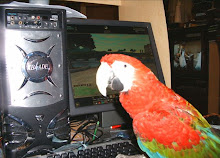 Here it is folks! Beta Pictoris and it's Jupiter size planet in living, false colour! Impressive isn't it?
Here it is folks! Beta Pictoris and it's Jupiter size planet in living, false colour! Impressive isn't it?
Ok, a little explanation is probably in order. Beta Pictoris is a star about 65 light years away. It's a little younger and a little hotter than our sun. Those two bright flame like objects coming out are actually a disc or ring made up of dust and debris from countless collisions of objects. This disc was imaged back in 1984 and is probably the best studied planetary disc there is. During it's long period of observation, it was discovered to be slightly warped or bent and a large number of comets were falling toward the star. It was postulated that a planet was the cause of the gravity disturbances that were observed. Scientists estimated the planet to be about the size of Jupiter and orbiting the star at a little over 8 AU (AU or Astronomical Unit is simply the average distance from the Earth to the Sun or roughly 93 million miles). This puts Beta Pictoris' planet at about the same orbit as Saturn is in our Solar System.
So, now we have a little context for the picture. The image was taken in the infrared part of the electromagnetic spectrum at a wavelength of 3.6 microns (about 5 times the wavelength that can be seen by the human eye). The star itself has been blocked out by various means so that objects close by could be seen. The planet, if it is a planet but a little more on that in a moment, can be seen as the small light blue dot at the 11 o'clock position on the image. This isn't another Earth, it's a very hot mass of material in the size range of Jupiter and probably 2 to 4 times bigger and it's very hot.
Now, I said above that there is a possibility that what the team of scientists imaged is not a planet after all. It could be something between us and Beta Pictoris. However, there is some strong evidence that points to it being a planet in orbit around the star. We see that the planetary disc has been disturbed in a similar fashion to what a large mass would do and we see the object in the same plane as the disc. We'll need to wait a while in order to make more images of the object and see if it moves in an orbit before we know for sure but right now, this looks good to be the fourth extra-solar planet imaged.
For a LOT more information, here's the ESO's press release
An Ultra-Fast Outflow Causes Scientists To Lower Mass Estimates Of The
Brighest Quasar In the Universe
-
[image: Artist's depiction of a quasar with a superfast outflow. Credit -
NOIRLab/NSF/AURA/J. da Silva/M. Zamani]
Peering back into the early years of th...
39 minutes ago





0 comments:
Post a Comment